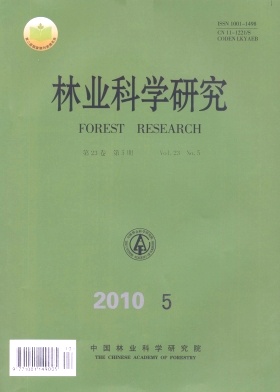|
[1]
|
Reichle D E.Dynamic Properties of Forest Ecosystems[M].London: Cambridge University Press,1982 |
|
[2]
|
Somogyi Z, Cienciala E, Makipaa R,et al. Indirect methods of large-scale forest biomass estimation[J]. European Journal of Forest Research,2007,126:197-207 |
|
[3]
|
Garkoti S S. Estimates of biomass and primary productivity in a high-altitude maple forest of the west central Himalayas[J]. Ecological Research,2008,23(1):41-49 |
|
[4]
|
Ketterings Q M, Coe R, Noordwijk K, et al. Reducing uncertainty in the use of allometric biomass equations for predicting above-ground tree biomass in mixed secondary forests[J].Forest Ecology and Management, 2001,146:199-209 |
|
[5]
|
Gupta S K.Energy structure of standing crop in certain grasslands at Gyanpur[J].Trop Ecol,1972,13:147-155 |
|
[6]
|
Jordan C F.Productivity of a tropical forest and its relation to a world pattern of energy storage [J].J Ecol,1971,59:127-142 |
|
[7]
|
张清海,叶功富,林益明.海岸退化沙地木麻黄人工林能量的研究[J].林业科学, 2006,42(8):1-7
|
|
[8]
|
陈少雄,刘杰锋,孙正军,等.桉树生物质能源的优势、现状和潜力[J].生物质化学工程,2006,40(增1):119-128
|
|
[9]
|
谢正生,陈北光,韩锦光,等.雷州两种桉树的生物量估测模型 //中国林学会桉树专业委员会第十三届学术交流会.中国林学会,1996
|
|
[10]
|
姚东和,杨民胜,李志辉.林分密度对巨尾桉生物产量及生产力的影响[J].中南林学院学报,2000,20(3):20-23
|
|
[11]
|
谢贤健,张 健,赖 挺,等.短轮伐期巨桉人工林地上部分生物量和生产力研究[J]. 四川农业大学学报, 2005,23(1): 66-74
|
|
[12]
|
黄世能,郑海水,何克军.桉树薪炭林混交试验 Ⅱ.林分生物量和能量分配的研究[J].林业科学研究, 1991,4(5):545-549
|
|
[13]
|
杨成源,张加研,李文政,等.滇中高原及干热河谷薪材树种热值研究[J].西南林学院学报,1996,16(4):294-302
|
|
[14]
|
周群英,陈少雄,吴志华,等.巨桉等5种桉树的热值和灰分含量[J].热带作物学报, 2009,30(2):161-166
|
|
[15]
|
陈少雄.桉树人工林土壤养分现状与施肥研究[J].桉树科技,2009,26(1):52-63
|
|
[16]
|
Ares A, Fownes J.Comparisions between generalized and specific tree biomass functions as applied to tropical ash (Fraxinue uhdei)[J].New Forests , 2000,20:277-286 |
|
[17]
|
Cienciaia, Cemy M, Tatarinov F, et al. Biomass functions applicable to Scots pine[J].Trees, 2006,20:483-495 |
|
[18]
|
张清海,叶功富,林益明,等.福建东山县赤山滨海沙地厚荚相思林与湿地松林生物量和能量的研究[J]. 厦门大学学报:自然科学版, 2005,44(1),123-127
|
|
[19]
|
陈 波,杨永川,周 莹.浙江天童常绿阔叶林内七种优势植物的热值研究[J].华东师范大学学报:自然科学版, 2006(2):105-111
|
|
[20]
|
陈美玲,上官周平.四种园林植物的热值与养分特征[J].应用生态学报, 2008,19(4):747-751
|
|
[21]
|
昝启杰,王伯荪,王勇军.深圳福田无瓣海桑-海桑林能量的研究[J].应用生态学报,2003,14(2):170-174
|
|
[22]
|
王文卿,叶庆华,王笑梅,等.盐胁迫对木榄幼苗各器官热值、能量积累及分配的影响[J].应用生态学报, 2001,12(1):8-12
|
|
[23]
|
候 庸,王伯荪,张宏达,等.广东黑石顶自然保护区南亚热带常绿阔叶林5种优势植物的热值研究[J].生态学报,1998,18(3):263-268
|
|
[24]
|
孙雪峰,陈灵芝,徐瑞成.暖温带落叶阔叶林林内能量的分配组合特征 //陈灵芝,黄建辉.暖温带生态系统结构与功能的研究.北京:科学出版社,1997,163-172
|
|
[25]
|
孙国夫,郑志明,王兆骞.水稻热值的动态变化研究[J].生态学杂志,1993,12(1):1-4
|
|
[26]
|
Hadley E B, Bliss L C. Energy relationships of alpine plants on Mt. Washington, New Hampshire [J].Ecol Monogr,1964,34: 331-357 |
|
[27]
|
胡宝忠,刘 娣,周以良,等.白三叶无性系植物种群分株间的资源分配[J].东北林业大学学报, 1998,26(2):25-28
|
|
[28]
|
刘 庆,钟章成.斑苦竹无性系种群能量结构研究[J].渝州大学学报:自然科学版, 1995,12(3): 22-27
|
|
[29]
|
乔秀娟,曹 敏,林 华.西双版纳不同林龄次生植物群落优势树种的热值[J].植物生态学报,2007,31(2): 326-332
|
|
[30]
|
曾小平,蔡锡安,赵 平,等.广东鹤山人工林群落主要优势植物的热值和灰分含量[J].应用生态学报, 2009,20(3):485-492
|
|
[31]
|
鲍雅静,李政海,韩兴国,等.植物热值及其生物生态学属性[J].生态学杂志,2006,25(9):1095-1103
|
|
[32]
|
张 林,黄 永,罗天祥,等.林分各器官生物量随林龄的变化规律——以杉木、马尾松人工林为例[J].中国科学院研究生院学报,2005,22(2):170-178
|
|
[33]
|
薛 鹏.雷州林业局6年生尾叶桉人工林生长量和生物量研究[J].桉树科技,2009,26(1):18-21
|
|
[34]
|
刘 茜.不同龄组马尾松人工林生物量及生产力的研究[J].中南林学院学报,1996,16(4):47-51
|





 DownLoad:
DownLoad: